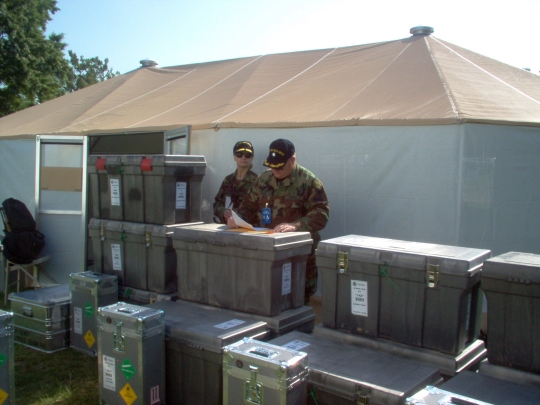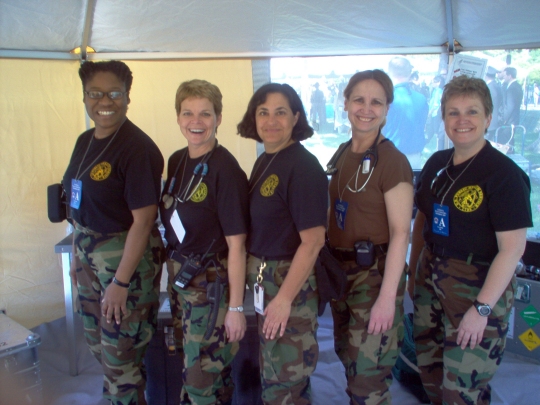

Supplies are dispersed to the four medical strike teams at the National Peace Officers’ Memorial Service.

Officers of the Commissioned Corps of the U.S. Public Health Service support the National Peace Officers’ Memorial Service. Pictured from left to right: LCDR Gettie Butts; LTJG Stacey McBryde; CAPT Angela Martinelli; CAPT Mary Purucker; and CDR Mary Rossi-Coajou.
| DC Area Officers of the Commissioned Corps of the U.S. Public Health Service Respond in Support of the 26th Annual National Peace Officers’ Memorial Service |
In 1962, President John F. Kennedy signed a proclamation that designated the 15th of May as National Peace Officers’ Memorial Day, and the week in which that date falls as “Police Week.” Every year since, tens of thousands of law enforcement officers from around the world have assembled in Washington, DC, to participate in events to honor fallen officers. Public Law 87-726, which was signed by the President in 1962, was amended by the 103rd Congress as part of the Violent Crime Control and Law Enforcement Act of 1994. President William J. Clinton signed Public Law 103-322 which directed that the flag of the United States on all government buildings be displayed at half-staff on 15 May, National Peace Officers’ Memorial Day, in honor of the sacrifice made by these fallen officers.
The first official memorial service took place on 15 May 1982. On that date, approximately 125 people gathered in Senate Park to honor 91 law enforcement officers. Over the past 25 years, more than 3,700 law enforcement officers from around our Nation have been honored. Today, the National Peace Officers’ Memorial Service has become one in a series of events that includes the Candlelight Vigil sponsored by the National Law Enforcement Officers Memorial Fund and seminars sponsored by Concerns of Police Survivors.
This year, the day began with muster in HHS Headquarters where Mr. Samuel Levy, the Operations Section Chief for the Emergency Management Group, led the briefing. After the briefing, the strike teams received communications equipment and proceeded to the west lawn of the Capitol for site orientation and set-up. The Incident Response Coordination Team performed an on-scene coordination of the medical strike teams. There were three medical tents. The Office of Preparedness and Emergency Operations provided supplies and equipment for performing basic and advanced life support functions.
Peace officers from every State in the Union were in attendance, as well as officers from around the world. Foreign countries represented at the event included Australia, Russia, and Canada, among others. Family members of 147 fallen officers were given seats of honor near the front of the stage. Bagpipers started the service followed by the U.S. Capitol Police Color Guard processional. Officer Patrick Nigh from the St. Louis County Police Department sang the National Anthem, and the invocation was given by Reverend Vytas Memenas from Illinois. The Grand Lodge Fraternal Order of Police president and their auxiliary president made welcoming remarks.
President George W. Bush was the keynote speaker. His words warmly and accurately described the appreciation Americans have for the peace officers of our Nation. The President shook the hand of each family member of the fallen officers, then each fallen officer’s name was read aloud as the families placed flowers on a large wreath. The service ended with the Memorial Guard final salute and echo taps.
While each medical tent and its staff were well-equipped and prepared to handle most serious emergencies, the majority of tent visitors were in need of hydration and temporary refuge from the heat and unrelenting midday sun. Approximately 120 people were seen by the deployed healthcare personnel during the event.
At one point, medical strike team #2 was suddenly dispatched into the crowd in search of a young woman with near-syncope at the same time the President was offering condolences to individual attendees at the event. Escorted by secret service and police, the team quickly arrived and was able to assess the patient, who had collapsed and was unable to ambulate, but still conscious and verbal. The team brought her by stretcher to another medical tent, instituted cooling measures, completed the assessment, and proceeded with the resuscitation. Following administration of 1 liter of IV fluids and supplementary oxygen by mask, EMS personnel arrived, and the patient was transported to a nearby hospital for definitive care.
At 1600 hours, the strike teams received instructions to stand down at which point they began to organize, inventory, and pack up the medical equipment for transport back to the NDMS truck. With the truck packed, cots, gurney, and medical tents disassembled, the teams began to walk back to HHS headquarters, where the day had begun some 10 hours earlier.
All in a day’s deployment.
Reference: http://www.policeweek.org/history.html